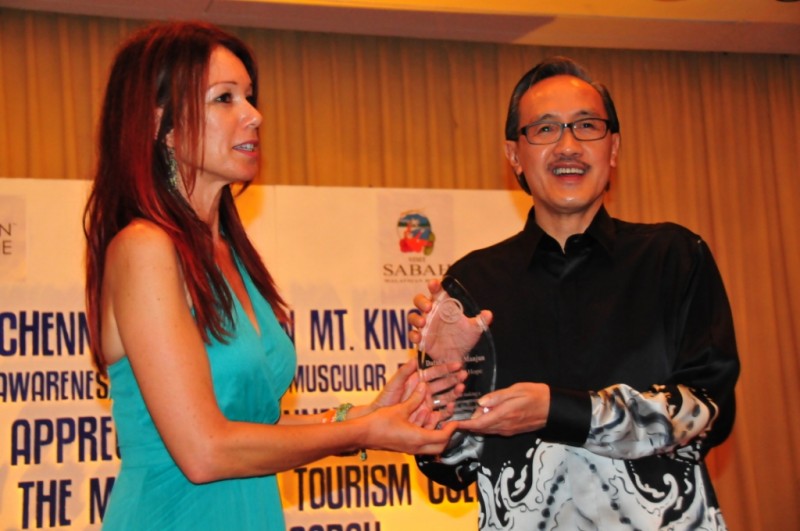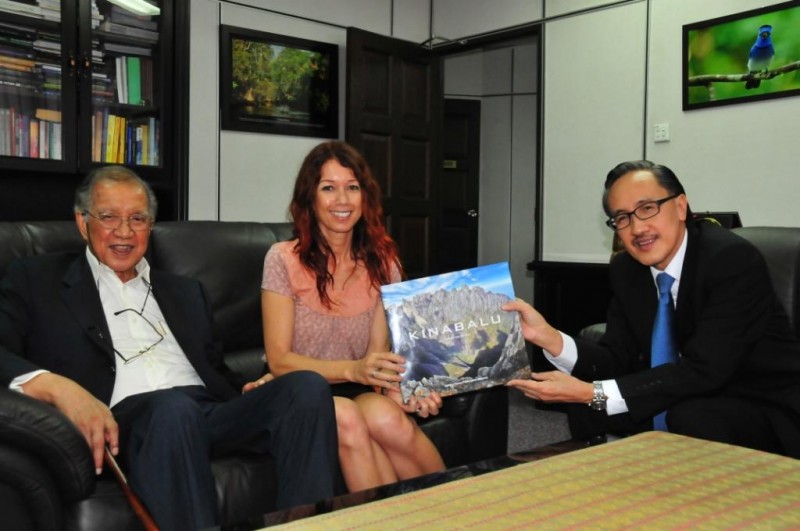jessica2013-08-23T14:49:41+08:00KOTA KINABALU: The race is on to save the Sumatran rhinoceros, especially the population in Sabah, from extinction.
Realizing just how dire the situation is with the animal, the State Government has given its approval for the target capture of a wild female rhino in Danum Valley for the purpose of producing baby rhinos.
The female rhino which has been identified through camera traps in Danum will be placed in an enclosure there so that she can mate with the existing male rhino in captivity with the hope that they can produce a baby.
Tourism, Culture and Environment Minister Datuk Masidi Manjun said that the approval was given early this year after the Cabinet was briefed on the current situation with regard to the Sumatran Rhinos in Sabah.
Masidi, after a meeting with the Sabah Wildlife Department, Universiti Malaysia Sabah (UMS) and WWF Malaysia yesterday, said that the long-term aim of the move is to re-establish a fully wild rhino population in the state.
“We think that there are no more than 10 Sumatran Rhinos living in Sabah. Even though some quarters claim that there are about 30, evidence collected via camera trap and other methods show that the number is not many. Probably it is safer to assume that not more than 10 in Sabah now.
“Of the total three are in captivity, including Tam, a male, and Puntung, a female, in Tabin Wildlife Reserve. These two have been together for more than two years for the purpose of captive breeding but there is no indication that they are even interested in mating,” he said.
Masidi added that capturing the female rhino is just one of the steps to be taken towards increasing the number of Sumatran rhinos is Sabah.
“We have given ourselves until July 2014 to see some results failing which we will consider working with the Cincinnati Zoo in United States of America for the rhino breeding purposes. We are looking at collecting Tam’s sperm and sending it to the zoo to be artificially inseminated into their Sumatran Rhino with the hope that it will produce a baby rhino.
“If that too fails, then we may have to send Tam on loan to Cincinnati Zoo as a mate for their sole female Sumatran rhino named Suci. Another option that we are considering is to send Tam’s sperm to our Indonesian counterparts to be artificially inseminated in their female captive rhino,” he said.
Should a baby rhino be born, it will stay at the Cincinnati Zoo because it does not matter where it is kept just as long as the species does not go extinct, he stressed, adding that the state government is pursuing every available option to save the species.
“We do not want to just wait until it’s too late to do something … we must act now,” he said.
Meanwhile, Sabah Wildlife Department director Datuk Dr Laurentius Ambu said that the department had consulted with a wide range of local and international expertise, including people managing wild and farmed African rhinos, zoo people, specialist vets, rhino ecologists and people who have been involved in saving other critically endangered birds and mammals, and some who have tried and failed.
According to Dr Laurentius, the only consensus is that the department has to act quickly to boost Sumatran rhino births.
Although a few international people do not agree, governmental and non-governmental professionals in Sabah say that there is now an urgent need to get as many rhinos into fenced, managed conditions as soon as possible, so that every rhino can be closely monitored and treated as necessary, to get them producing embryos, he said.
“In my opinion, the exact location where the rhinos are kept is not paramount concern for this programme. We can move them between facilities as long as the care is always world class and the intention is to breed rhinos. I do believe that at this case, Sabah can and should take a leadership role,” he stressed.
“The problem now with wild Sumatran rhinos lies in an obscure wildlife biology concept, called the Allee Effect,” explained Dr Sen Nathan, assistant director to the department.
“Once numbers of a species go below a certain threshold level, breeding success falls below death rate, and the species is set on a steady trajectory to extinction, even in protected areas such as Tabin and Danum Valley.
Poaching may hasten extinction, but preventing poaching will not prevent extinction. Factors involved include inability of fertile females and males to find each other, reproductive pathology induced by long periods with no breeding, and inbreeding because only siblings remain in one area,” Dr Sen said.
He believes that advanced and possibly as yet undiscovered reproductive technologies will be needed in order to maximize prospects for producing Sumatran rhino babies.
WWF-Malaysia Executive Director/CEO, Datuk Dr Dionysius Sharma who was also present at the press conference pointed out that there is imminent need to translocate the remaining wild Sumatran rhinos in Sabah to captivity as this is a key possibility to beat the looming threat of total extinction of the species.
“We need to expedite this action as the rhinos are at the risk of being poached out or die naturally if left in the wild,” he said, adding that that WWF-Malaysia is working closely with its partners to conduct surveys in the Danum Valley to identify locations of the remaining rhinos, and patrolling the area to protect the rhinos until they are captured for translocation to the Borneo Rhino Sanctuary.
The Borneo Rhino Sanctuary programme was approved by the government of Sabah in 2009, with the aim to prevent the rhinos extinction in Sabah. So far, only two rhinos are in the sanctuary facilities in Tabin Wildlife Reserve.
Tam is a fertile but aging male, while Puntung is a younger female, who probably cannot become pregnant by natural means because she has significant endometrial cyst growth in her reproductive organs.
In March 2013, the government gave approval to target capture of a wild female rhino in Danum Valley. The long-term aim is to re-establish a fully wild rhino population but the immediate task is to maximize the contribution of every single rhino towards the goal of producing more baby rhinos.
In July 2013, several local NGOs and institutions agreed to support a way forward. If Sabah cannot secure a new, fertile mate for Tam before July 2014, Tam will be loaned to Cincinnati Zoo as a mate for their sole female Sumatran rhino named Suci. Why Cincinnati? Because this is the only zoo in the world which has successfully bred Sumatran rhinos, producing an infant in 2001 (a male named Andalas), 2004 (a female named Suci) and 2007 (another male named Harapan).
The parents of these three rhinos have died of age-related diseases. The first born male, Andalas, was returned to Indonesia in 2007 and he fathered a baby in 2012. In desperation, Cincinnati Zoo has made it known that they will try to mate Suci with her younger brother Harapan as soon as he is sexually mature, but all observers say that this is a last resort, aimed at breeding Suci before endometriosis starts to set in.
The NGOs and institutions that gave their blessings to the Cincinnati loan plan include Borneo Conservation Trust (BCT), Borneo Rhino Alliance (BORA), Danau Girang Field Centre, HUTAN, Land Empowerment, Animals, People (LEAP), Malaysian Nature Society (Sabah Branch), Malaysian Association of Tour & Travel Agents (MATTA), Royal Society Southeast Asian Rainforest Research (SEARPP) programme, Sabah Environmental Protection Association (SEPA), Sabah Environmental Trust, Sabah Tourist Guides Association (STGA), The Sabah Society and WWF-Malaysia.
“There may be about a hundred Sumatran rhinos left in Sumatra, but when numbers get that low, in a nation with a large and growing human population, things don’t look good there either,” said Datuk Junaidi Payne, executive director of a Sabah-based NGO, Borneo Rhino Alliance.
“We have been in frequent contact with our Indonesian counterparts for several years, and the message that we get is that they are very hesitant to contemplate bringing in more wild rhinos into fenced, managed conditions, despite the enormous threats to the wild rhinos. Their reluctance is in part due to fear of public criticism,” he said.
Junaidi believes that Sabah should collaborate with Indonesia and the best global specialists in sharing rhinos, or rhino ova and sperm, for a globally managed breeding programme.
“We could together reverse the long-term fatal trend that this species is now in, and start to get more births than deaths. Sabah has fewer rhinos and fewer options, but paradoxically there is now the need for Sabah to take a leadership role,” he said.
Source: Borneo Post





